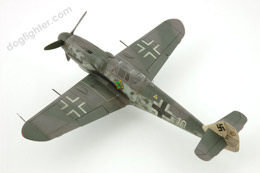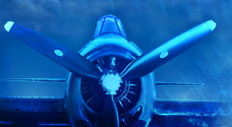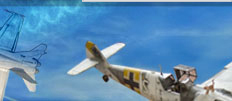|
|
|
who developed the new fighter aircraft from
a sports acrobatic plane, the Messerschmitt Bf-108 - believed in a low-weight, simple monoplane with innovative
construction, such as attaching the landing gear to the fuselage. The first prototype,
the Messerschmitt Bf 109 V1, was equipped with a Rolls Royce Kestrel VI engine, made its maiden flight
on May 28, 1935, and was followed by two other prototypes. Willy Messerschmitt - who developed the new fighter aircraft from
a sports acrobatic plane, the Messerschmitt Bf-108 - believed in a low-weight, simple monoplane with innovative
construction, such as attaching the landing gear to the fuselage.
The first Messerschmitt Bf-109 that went to series production was the B1 model with a newly installed Jumo 210B engine.
Experiences in the Spanish Civil War lead to the creation of the type C, finally carrying five MG 17 machine guns on the
wings and on the nose of the aircraft. The following type D ("Dora") was tested in the first World War II air battles
but saw limited service and was soon replaced by the type E ("Emil"), famous for its deployment in the Battle of Britain
(July 7 - October 31, 1940). The following type F ("Friedrich"), improved by changes in aerodynamics, served along with
the type K until the end of World War II, mainly for purposes of training and exploration. Another new type, the Messerschmitt
Kf-109 G, was designed in 1940 and remained in use until the 1950s.
The Messerschmitt Bf-109 K came into the world in 1943; its series production was launched
a year later. Willy Messerschmitt was asked to rationalize production and create a standard model by consolidating parts of
previous Messerschmitts Bf 109s because resources were running low due to the long-lasting war. The designer constructed
four variants: K6, K8, K14 and the K4 type, which became by far the most widespread of the Bf-109 Ks with 1,700 units
constructed before the end of World War II.
Technical Parameters: The Messerschmitt Bf-109 K4, designed as a single-seater fighter aircraft,
is an all-metal aircraft made of Dural and other aluminum alloys. It has a three-vane variable pitch propeller run
by a cylindrical petrol water-cooled engine. The K4 was the only of all the Messerschmitt Bf-109s equipped with fully
attached hatches on both the landing gear and the tailskid.
Designed to reach high speed, having considerable firing strength, and being easy to maneuver, the Bf-109 K was able
to either deftly flee from troublesome situations or catch up with and destroy enemy aircraft. These qualities sometimes
prepared an unpleasant surprise for the Allies who tended to underestimate the Messerschmitt. However, the Bf-109 Ks
often could not make full use of its technical potential because of the huge losses among German soldiers that resulted
in the deployment of under-trained pilots, which ultimately determined their fate. It is necessary to add that the
Messerschmitt Bf-109 Ks were a success in the Eastern Front where they achieved many victories in World War II air battles.
|
|
|
| Length | 9020 mm |
| Width | 9920 mm |
| Height | 3370 mm |
| Propeller diameter | 3000 mm |
| Aerofoil | 24.18 M² |
| Max. weight | 3362 kg |
| Net weight | 2346 kg |
| Armament payload | 176 + 46 kg |
| Max speed | 680 km/h at 9,000 M |
| Average speed | 585 km/h at 7,500 M |
| Landing speed | 150 km/h |
| Max. ceiling | 12,200 M |
| Range | 640 km |
| Engine | DB650 D power 1,450 kW; 2800 RPM; 12 cylinders |
| Armament | 2x MG 131 + MK 108 |
|
|
The Model: Let's ask the builder!
What kind of kit did you use for this Messerschmitt Kf-109 K4?
I decided on the Japanese Hasegawa kit - it seems to be the most authentic one available. The K-4 is made of
light-gray plastic with negative panel lines. The plastic is rather hard and brittle but this is quite common
with the Hasegawa kits. On the other hand, the thinness and quality of the transparent parts are just excellent.
What was the first thing you hurled yourself into?
I started by constructing the wings; a narrow part for pushing in the landing gear leg was shaped
and a new etched part with oval holes was attached into this space. After that, the main landing gear
bay was glued into the wing area where the wheels of the main landing gear rest when it is retracted. However,
I wasn’t too happy about the flat surfaces - the landing gear bay was in reality recessed because
of the bulky rubber of the main landing wheel. This meant that there was an elongated bulginess
on the superior surface of the wing, which served as an aerodynamic cover for the main landing gear
wheel. The wings were finally put together and allowed to dry.
And what about the cockpit?
I started on the cockpit detail set (see cockpit photos below) while the wings were drying out. When
the etched dashboard looks pretty good, I then spray the cockpit with standard RLM 66 Schwarzgrau paint,
drybrush the kit with white oil paint,
and finally put the fuselage together. The next step is to glue the wings and the tail parts to the fuselage
and paint the joint with Surfacer 500 to give it a consistent look. After re-surfacing the whole kit, the
front part of the cockpit is glued, masked, and sprayed with RLM 66. The good thing is that the Hasegawa
kit has the front part of the cockpit connected to the fuselage. All the parts fit perfectly and
there is no need to glue the cockpit to the fuselage.
|
|

|
|
|
|
|
 |
|
| |
|
|
| |
 |
|
mouseover the thumbnail images to see a larger preview on the right
click the thumbnail image to view full size image on the top |
|
|
|
|
| |
|
|
|
|
|
|
Other Dogfighters:
(Click photo for more info)
|
Messerschmitt Me Bf 109 G-6 1:48

|
Sukhoi Su-7 BMK

|
MiG-29 A

|
messerschmitt me109 E-4 1:48

|
Russian military airplane ICM MiG-3 1:48

|
luftwaffe secret technology Horten 229A-1 Flying Wing

|
Sikorsky helicopters Revell CH-54 Sikorsky Tarhe

|
|
|
|
|
Italeri Sukhoi Su-24M

|
F-8E Crusader

|
|

















